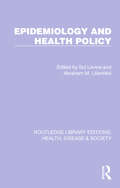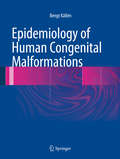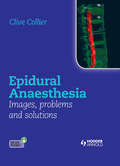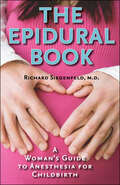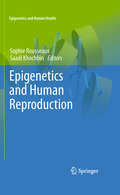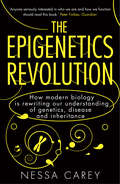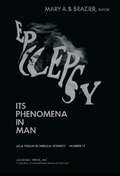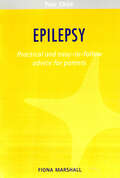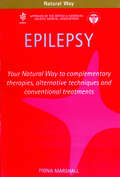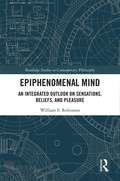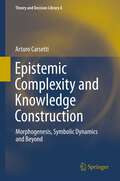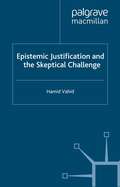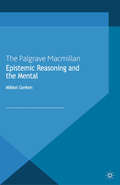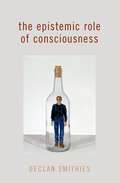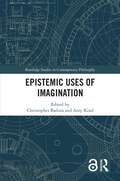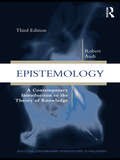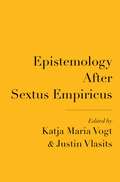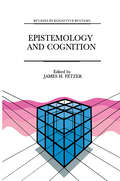- Table View
- List View
Epidemiology and Health Policy (Routledge Library Editions: Health, Disease and Society #18)
by Sol Levine Abraham LilienfeldOriginally published in 1987, this book examines the priorities of health policy in the late 20th Century and the varied approaches or strategies to foster the prevention or control of disease. Several chapters focus on specific diseases and conditions, but other areas of concern such as injuries, alcoholism, drug-abuse, occupational health and nutrition are also dealt with. The book illuminates how epidemiology can serve as a more effective basis for health policy and practice and will be of great value to students and lecturers of medical sociology, epidemiological medicine and health policy.
Epidemiology and Health Policy (Routledge Library Editions: Health, Disease and Society #18)
by Sol Levine Abraham LilienfeldOriginally published in 1987, this book examines the priorities of health policy in the late 20th Century and the varied approaches or strategies to foster the prevention or control of disease. Several chapters focus on specific diseases and conditions, but other areas of concern such as injuries, alcoholism, drug-abuse, occupational health and nutrition are also dealt with. The book illuminates how epidemiology can serve as a more effective basis for health policy and practice and will be of great value to students and lecturers of medical sociology, epidemiological medicine and health policy.
Epidemiology of Human Congenital Malformations
by Bengt KällénAuthored by Bengt Källén, professor emeritus in embryology at Lund University in Sweden.The subject of this book is to describe the occurrence of congenital malformations among children born and what risk factors exist. Population data are presented for a number of malformations, ascertained with the use of data from the Swedish national health registers for the period 1998-2010 corresponding to some 1.3 million births, together with prospectively collected information on a group of exposures of possible interest. The structure of the analysis is such that it excludes studies of, for instance, nutrition, alcohol or street drug use and many other lifestyle factors where prospective information or independent register information is difficult or impossible to obtain. Epidemiology of Human Congenital Malformations culminates with a discussion on how the presence of malformations can be explained and various possibilities for the prevention of birth defects. Moreover, it will include a series of instructions on how to read epidemiological literature in this field making it an essential resource both for those currently working in the field of reproductive epidemiology or those intending to enter it. It will additionally be useful for doctors working with malformations, either as obstetricians, neonatologists or pediatricians.
Epidural Anaesthesia: Images, Problems and Solutions
by Clive CollierEpidural Anaesthesia: Images, Problems and Solutions brings together the most comprehensive collection of post-block epidurograms in the world into a single volume. With accompanying X-rays and contrast injection images, it clearly explains why an epidural block has failed and provides practical advice on how to avoid complications in the future.Ke
The Epidural Book: A Woman's Guide to Anesthesia for Childbirth
by Richard SiegenfeldThe majority of women giving birth in the United States receive an epidural during labor and delivery; many others receive a spinal block. The Epidural Book fully explains anesthesia used during labor and vaginal delivery or C-section, with an emphasis on epidurals. Dr. Richard Siegenfeld answers pregnant women's questions, including • Who administers epidurals and spinal blocks and when?• How does anesthesia affect both the mother and the baby?• Under what circumstances should a woman avoid an epidural?• What happens during the recovery period?• What problems can arise?Written by an experienced anesthesiologist, The Epidural Book is lighthearted and informative. This easy-to-read guide helps an expectant mother prepare for her all-important day.
The Epidural Book: A Woman's Guide to Anesthesia for Childbirth
by Richard SiegenfeldThe majority of women giving birth in the United States receive an epidural during labor and delivery; many others receive a spinal block. The Epidural Book fully explains anesthesia used during labor and vaginal delivery or C-section, with an emphasis on epidurals. Dr. Richard Siegenfeld answers pregnant women's questions, including • Who administers epidurals and spinal blocks and when?• How does anesthesia affect both the mother and the baby?• Under what circumstances should a woman avoid an epidural?• What happens during the recovery period?• What problems can arise?Written by an experienced anesthesiologist, The Epidural Book is lighthearted and informative. This easy-to-read guide helps an expectant mother prepare for her all-important day.
Epigenetics and Human Reproduction (Epigenetics and Human Health)
by Sophie Rousseaux and Saadi KhochbinEpigenetics is a rapidly expanding field in medical and biological research which concerns heritable traits that are not attributable to changes in the DNA sequence. Epigenetic mechanisms play key roles in many biological processes, and it has become clear that their disruption can gives rise to diverse pathologies in humans. Edited by preeminent experts, Sophie Rousseaux and Saadi Khochbin, this volume in the ‘Epigenetics and Human Health’ series discusses the role of epigenetics in human reproduction
The Epigenetics Revolution: How Modern Biology is Rewriting our Understanding of Genetics, Disease and Inheritance
by Nessa Carey'A book that would have had Darwin swooning - anyone seriously interested in who we are and how we function should read this.' Guardian At the beginning of this century enormous progress had been made in genetics. The Human Genome Project finished sequencing human DNA. It seemed it was only a matter of time until we had all the answers to the secrets of life on this planet. The cutting-edge of biology, however, is telling us that we still don't even know all of the questions. How is it that, despite each cell in your body carrying exactly the same DNA, you don't have teeth growing out of your eyeballs or toenails on your liver? How is it that identical twins share exactly the same DNA and yet can exhibit dramatic differences in the way that they live and grow? It turns out that cells read the genetic code in DNA more like a script to be interpreted than a mould that replicates the same result each time. This is epigenetics and it's the fastest-moving field in biology today. The Epigenetics Revolution traces the thrilling path this discipline has taken over the last twenty years. Biologist Nessa Carey deftly explains such diverse phenomena as how queen bees and ants control their colonies, why tortoiseshell cats are always female, why some plants need a period of cold before they can flower, why we age, develop disease and become addicted to drugs, and much more. Most excitingly, Carey reveals the amazing possibilities for humankind that epigenetics offers for us all - and in the surprisingly near future.
Epilepsy: Its Phenomena in Man
by Mary A. B. BrazierEpilepsy: Its Phenomena in Man is a 16-chapter text that covers the wide field of the phenomena of epilepsy in man. This book emerged from the manuscripts presented by the scientific program of an alumni reunion of the Brain Research Institute of the University of California, Los Angeles. The introductory chapters review the role of electricity in the exploration and elucidation of the epileptic seizure, as well as the role of synaptic organization of the cerebral cortex in epilepsy. The succeeding chapters deal with the neuroglial impairment hypothesis, the particular forms of experimental epilepsy in man, and their corresponding surgical treatment. These topics are followed by discussions of the problem of synchronization in the spread of epileptic discharges leading to seizures and the behavioral correlations of generalized spike-wave discharge in the electroencephalogram. Other chapters explore the common anatomy of psychomotor epilepsy and schizophrenia; time of occurrence of seizures; the clinical ictal patterns and electrographic data in partial seizure cases; and the problems of analysis and interpretation of electrocerebral signals in human epilepsy. The concluding chapters consider the developments in direct recordings from epileptogenic regions in the surgical treatment of partial epilepsies. These chapters also examine the golgi survey concerning hippocampal pathology in temporal lobe epilepsy and the structural substrates of seizure foci.This book will prove useful to neuroscientists and the workers in biomedical fields critical for the understanding of epileptogenesis.
Epilepsy
by Fiona MarshallWhile epilepsy may not be curable, parents can do a great deal to help their child cope with its effects. This book looks at the effective complementary and conventional treatments that can help reduce the intensity and frequency of seizures, and increase the control of the epilepsy. It includes stress-management techniques and ways to help your child create a positive self-image.
Epilepsy
by Fiona MarshallEpilepsy is surprisingly common and affects an enormous number of people, often with extremely debilitating effects on their lifestyle and helth. In the last few years there has emerged growing evidence that complementary and alternative treatments can play an important part in improving the quality of life for many sufferers.
Epiphenomenal Mind: An Integrated Outlook on Sensations, Beliefs, and Pleasure (Routledge Studies in Contemporary Philosophy)
by William S. RobinsonAccording to epiphenomenalism, our behavior is caused by events in our brains that also cause our mentality. This resulting mentality reflects our brains’ organization, but does not in turn cause anything. This book defends an epiphenomenalist account of philosophy of mind. It builds on the author’s previous work by moving beyond a discussion of sensations to apply an epiphenomenalist outlook to other aspects of mental causation such as beliefs, desires, pleasure, and displeasure. The first four chapters of the book argue for a dualistic theory of sensations and develop an epiphenomenalist version of dualism. The remaining chapters discuss propositional attitudes and valence. The author also responds to potential objections to epiphenomenalism by considering how sensations, intelligence, or understanding might be built into a robot. This book will be of interest to scholars and students in philosophy of mind who are interested in consciousness, mental causation, and how our mentality is situated in the world.
Epiphenomenal Mind: An Integrated Outlook on Sensations, Beliefs, and Pleasure (Routledge Studies in Contemporary Philosophy)
by William S. RobinsonAccording to epiphenomenalism, our behavior is caused by events in our brains that also cause our mentality. This resulting mentality reflects our brains’ organization, but does not in turn cause anything. This book defends an epiphenomenalist account of philosophy of mind. It builds on the author’s previous work by moving beyond a discussion of sensations to apply an epiphenomenalist outlook to other aspects of mental causation such as beliefs, desires, pleasure, and displeasure. The first four chapters of the book argue for a dualistic theory of sensations and develop an epiphenomenalist version of dualism. The remaining chapters discuss propositional attitudes and valence. The author also responds to potential objections to epiphenomenalism by considering how sensations, intelligence, or understanding might be built into a robot. This book will be of interest to scholars and students in philosophy of mind who are interested in consciousness, mental causation, and how our mentality is situated in the world.
Epistemic Complexity and Knowledge Construction: Morphogenesis, symbolic dynamics and beyond (Theory and Decision Library A: #45)
by A. CarsettiThe volume as its first target aims at clarifying that peculiar entanglement of complexity, causality, meaning, emergence and intentionality that characterises the unfolding of the "natural forms" of human cognitionAs is well known, cognition is not only a self-organising process. It is also a co-operative and coupled process. If we consider the external environment as a complex, multiple and stratified Source which interacts with the nervous system, we can easily realise that the cognitive activities devoted to the "intelligent" search for the depth information living in the Source, may determine the very change of the complexity conditions according to which the Source progressively expresses its "wild" action. In this sense, simulation models are not neutral or purely speculative: the true cognition actually appears to be necessarily connected with successful forms of reading, those forms, in particular, that permit a specific coherent unfolding of the deep information content of the Source. Therefore, the simulation models, if valid, materialise as "creative" channels, i.e., as autonomous functional systems, as the very roots of a new possible development of the entire system represented by mind and its Reality. From a general point of view, the objectivity of Reality is also proportionate to the autonomy reached by cognitive processes. In this sense, at the level of cultural evolution, reference procedures act as guide, mirror and canalisation with respect to primary information flows and involved selective forces: they offer themselves as the actual instruments for the constant renewal of the code, for the invention and the actual articulation of an ever-new incompressibility. From an effective point of view, they appear as indissolubly linked to the successive definition of specific (and innovative) measures of the epistemic complexity. These measures cannot concern only statistical rarity (Shannon) or computational incompressibility (Kolmogorov-Chaitin), on the contrary they should also be able to take into account the coupled connection between the Source and the cognitive agent, the evolution of this connection as well as the successive constitution of meaning as symbolic form. Hence the possible (and necessary) definition of new axiomatic systems, new measure spaces, the real displaying of processes of continuous reorganisation at the semantic level. Indeed, it is only through a complete, first-order "reduction" and a correlated non-standard second-order analysis that new incompressibility will actually manifest itself. Therefore, the reference procedures appear to be related to a process of multiplication of minds, as well as to a process of "clarification" of meanings which finally emerges as vision via principles.
Epistemic Justification and the Skeptical Challenge
by H. VahidThis book explores the concept of epistemic justification and our understanding of the problem of skepticism. Providing critical examination of key responses to the skeptical challenge, Hamid Vahid presents a theory which is shown to work alongside the internalism/externalism issue and the thesis of semantic externalism, with a deontological conception of justification at its core.
Epistemic Reasoning and the Mental (Palgrave Innovations in Philosophy)
by M. GerkenEpistemic Reasoning and the Mental integrates the epistemology of reasoning and philosophy of mind. By examining the fundamental competencies involved in reasoning, Gerken argues that reasoning depends on the external environment in ways that are both surprising and epistemologically important.
The Epistemic Role of Consciousness (Philosophy of Mind Series)
by Declan SmithiesWhat is the role of consciousness in our mental lives? Declan Smithies argues here that consciousness is essential to explaining how we can acquire knowledge and justified belief about ourselves and the world around us. On this view, unconscious beings cannot form justified beliefs and so they cannot know anything at all. Consciousness is the ultimate basis of all knowledge and epistemic justification. Smithies builds a sustained argument for the epistemic role of phenomenal consciousness which draws on a range of considerations in epistemology and the philosophy of mind. His position combines two key claims. The first is phenomenal mentalism, which says that epistemic justification is determined by the phenomenally individuated facts about your mental states. The second is accessibilism, which says that epistemic justification is luminously accessible in the sense that you're always in a position to know which beliefs you have epistemic justification to hold. Smithies integrates these two claims into a unified theory of epistemic justification, which he calls phenomenal accessibilism. The book is divided into two parts, which converge on this theory of epistemic justification from opposite directions. Part 1 argues from the bottom up by drawing on considerations in the philosophy of mind about the role of consciousness in mental representation, perception, cognition, and introspection. Part 2 argues from the top down by arguing from general principles in epistemology about the nature of epistemic justification. These mutually reinforcing arguments form the basis for a unified theory of the epistemic role of phenomenal consciousness, one that bridges the gap between epistemology and philosophy of mind.
The Epistemic Role of Consciousness (Philosophy of Mind Series)
by Declan SmithiesWhat is the role of consciousness in our mental lives? Declan Smithies argues here that consciousness is essential to explaining how we can acquire knowledge and justified belief about ourselves and the world around us. On this view, unconscious beings cannot form justified beliefs and so they cannot know anything at all. Consciousness is the ultimate basis of all knowledge and epistemic justification. Smithies builds a sustained argument for the epistemic role of phenomenal consciousness which draws on a range of considerations in epistemology and the philosophy of mind. His position combines two key claims. The first is phenomenal mentalism, which says that epistemic justification is determined by the phenomenally individuated facts about your mental states. The second is accessibilism, which says that epistemic justification is luminously accessible in the sense that you're always in a position to know which beliefs you have epistemic justification to hold. Smithies integrates these two claims into a unified theory of epistemic justification, which he calls phenomenal accessibilism. The book is divided into two parts, which converge on this theory of epistemic justification from opposite directions. Part 1 argues from the bottom up by drawing on considerations in the philosophy of mind about the role of consciousness in mental representation, perception, cognition, and introspection. Part 2 argues from the top down by arguing from general principles in epistemology about the nature of epistemic justification. These mutually reinforcing arguments form the basis for a unified theory of the epistemic role of phenomenal consciousness, one that bridges the gap between epistemology and philosophy of mind.
Epistemic Uses of Imagination (Routledge Studies in Contemporary Philosophy)
by Helen Donaghue Christopher BaduraThis book explores a topic that has recently become the subject of increased philosophical interest: how can imagination be put to epistemic use? Though imagination has long been invoked in contexts of modal knowledge, in recent years philosophers have begun to explore its capacity to play an epistemic role in a variety of other contexts as well. In this collection, the contributors address an assortment of issues relating to epistemic uses of imagination, and in particular, they take up the ways in which our imaginings must be constrained so as to justify beliefs and give rise to knowledge. These constraints are explored across several different contexts in which imagination is appealed to for justification, namely reasoning, modality and modal knowledge, thought experiments, and knowledge of self and others. Taken as a whole, the contributions in this volume break new ground in explicating when and how imagination can be epistemically useful. Epistemic Uses of Imagination will be of interest to scholars and advanced students who are working on imagination, as well as those working more broadly in epistemology, aesthetics, and philosophy of mind.
Epistemic Uses of Imagination (Routledge Studies in Contemporary Philosophy)
by Amy Kind Christopher BaduraThis book explores a topic that has recently become the subject of increased philosophical interest: how can imagination be put to epistemic use? Though imagination has long been invoked in contexts of modal knowledge, in recent years philosophers have begun to explore its capacity to play an epistemic role in a variety of other contexts as well. In this collection, the contributors address an assortment of issues relating to epistemic uses of imagination, and in particular, they take up the ways in which our imaginings must be constrained so as to justify beliefs and give rise to knowledge. These constraints are explored across several different contexts in which imagination is appealed to for justification, namely reasoning, modality and modal knowledge, thought experiments, and knowledge of self and others. Taken as a whole, the contributions in this volume break new ground in explicating when and how imagination can be epistemically useful. Epistemic Uses of Imagination will be of interest to scholars and advanced students who are working on imagination, as well as those working more broadly in epistemology, aesthetics, and philosophy of mind.
Epistemology: A Contemporary Introduction to the Theory of Knowledge
by Robert AudiEpistemology, or “the theory of knowledge,” is concerned with how we know what we know, what justifies us in believing what we believe, and what standards of evidence we should use in seeking truths about the world and human experience. This comprehensive introduction to the field of epistemology explains the concepts and theories central to understanding knowledge. Along with covering the traditional topics of the discipline in detail, Epistemology explores emerging areas of research. The third edition features new sections on such topics as the nature of intuition, the skeptical challenge of rational disagreement, and “the value problem” – the range of questions concerning why knowledge and justified true belief have value beyond that of merely true belief. Updated and expanded, Epistemology remains a superb introduction to one of the most fundamental fields of philosophy. Special features of the third edition of Epistemology include: a comprehensive survey of basic concepts, major theories, and emerging research in the field enhanced treatment of key topics such as contextualism, perception (including perceptual content), scientific hypotheses, self-evidence and the a priori, testimony, understanding, and virtue epistemology expanded discussion of the relation between epistemology and related fields, especially philosophy of mind, philosophy of science, and ethics increased clarity and ease of understanding for an undergraduate audience an updated list of key literature and annotated bibliography.
Epistemology: A Contemporary Introduction to the Theory of Knowledge
by Robert AudiEpistemology, or “the theory of knowledge,” is concerned with how we know what we know, what justifies us in believing what we believe, and what standards of evidence we should use in seeking truths about the world and human experience. This comprehensive introduction to the field of epistemology explains the concepts and theories central to understanding knowledge. Along with covering the traditional topics of the discipline in detail, Epistemology explores emerging areas of research. The third edition features new sections on such topics as the nature of intuition, the skeptical challenge of rational disagreement, and “the value problem” – the range of questions concerning why knowledge and justified true belief have value beyond that of merely true belief. Updated and expanded, Epistemology remains a superb introduction to one of the most fundamental fields of philosophy. Special features of the third edition of Epistemology include: a comprehensive survey of basic concepts, major theories, and emerging research in the field enhanced treatment of key topics such as contextualism, perception (including perceptual content), scientific hypotheses, self-evidence and the a priori, testimony, understanding, and virtue epistemology expanded discussion of the relation between epistemology and related fields, especially philosophy of mind, philosophy of science, and ethics increased clarity and ease of understanding for an undergraduate audience an updated list of key literature and annotated bibliography.
Epistemology After Sextus Empiricus
by Katja Maria Vogt and Justin VlasitsSextus Empiricus was the voice of ancient Greek skepticism for posterity. His writings contain the most subtle and detailed versions of the ancient skeptical arguments known as Pyrrhonism, adding up to a distinctive philosophical approach. Instead of viewing philosophy as valuable because of the answers it gives to important questions, Sextus considered the search for answers itself to be fundamental and offered a philosophy centered on inquiry. Assuming the point of view of an active inquirer, Sextus developed arguments concerning conflicting appearances, infinite regress in argument, dogmatic assertion of premises that are insufficiently justified, and many other ideas that fascinated later philosophers of knowledge across the centuries. He provided a unique perspective on topics of enduring relevance such as perception, language, logical consequence, belief, ignorance, disagreement, and induction. While Sextus's importance to epistemology was appreciated by early modern and modern philosophers, he is underrepresented in contemporary discussions. In order to put Sextus back in the center of epistemology, these essays discuss his influence in the history of modern philosophy as well as contemporary engagements with Sextus's version of Pyrrhonian skepticism. The contributors investigate epistemology after Sextus, addressing four core themes of Sextus's skepticism: appearances and perception, the structure of justification and proof, belief and ignorance, and ethics and action. The arguments presented here bridge the divide between contemporary and ancient debates about knowledge and skepticism and will appeal to philosophers interested in epistemology and philosophy of mind as well as those interested in ancient philosophy and the history of philosophy more generally.
Epistemology After Sextus Empiricus
Sextus Empiricus was the voice of ancient Greek skepticism for posterity. His writings contain the most subtle and detailed versions of the ancient skeptical arguments known as Pyrrhonism, adding up to a distinctive philosophical approach. Instead of viewing philosophy as valuable because of the answers it gives to important questions, Sextus considered the search for answers itself to be fundamental and offered a philosophy centered on inquiry. Assuming the point of view of an active inquirer, Sextus developed arguments concerning conflicting appearances, infinite regress in argument, dogmatic assertion of premises that are insufficiently justified, and many other ideas that fascinated later philosophers of knowledge across the centuries. He provided a unique perspective on topics of enduring relevance such as perception, language, logical consequence, belief, ignorance, disagreement, and induction. While Sextus's importance to epistemology was appreciated by early modern and modern philosophers, he is underrepresented in contemporary discussions. In order to put Sextus back in the center of epistemology, these essays discuss his influence in the history of modern philosophy as well as contemporary engagements with Sextus's version of Pyrrhonian skepticism. The contributors investigate epistemology after Sextus, addressing four core themes of Sextus's skepticism: appearances and perception, the structure of justification and proof, belief and ignorance, and ethics and action. The arguments presented here bridge the divide between contemporary and ancient debates about knowledge and skepticism and will appeal to philosophers interested in epistemology and philosophy of mind as well as those interested in ancient philosophy and the history of philosophy more generally.
Epistemology and Cognition (Studies in Cognitive Systems #6)
by James H. FetzerThis series will include monographs and collections of studies devoted to the investigation and exploration of knowledge, information, and data-processing systems of all kinds, no matter whether human, (other) animal, or machine. Its scope is intended to span the full range of interest from classical problems in the philosophy of mind and philosophical psychology through issues in cognitive psychology and sociobiology (concerning the mental powers of other species) to ideas related to artificial intelligence and computer science. While primary emphasis will be placed upon theoretical, conceptual, and epistemological aspects of these problems and domains, empirical, experimen tal, and methodological studies will also appear from time to time. The present volume reflects the kind of insights that can be obtained when research workers in philosophy, artificial intelligence, and computer science explore problems of common concern. The issues here tend to fall into two broad but varied sets, namely: those concerned with content and concepts, on the one hand, and those concerned with semantics and epistemology, on the other. The collection begins with a prologue that focuses upon the relations between connectionism and alternative conceptions of nativism and ends with an epilogue that examines the significance of alternative conceptions of the Frame Problem for artificial intelligence. Because these papers are rich and diverse, they ought to appeal to a wide and heterogeneous audience. J.H.F.
